2020 Ford Escape Hybrid
2020 Ford Escape Hybrid Review By Car Critic Steve Hammes
The venerable Escape has long since been a small SUV favorite but as you can see Ford has taken its styling in a decidedly car-like direction repositioning it in their reborn, utility-focused lineup.
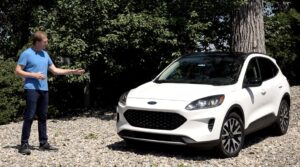 The Escape is America’s small SUV. Having been on the road now for 20 years, it’s where we’ve turned when the patriotic pangs pull us away from the RAV4, CR-V and Rogue.
The Escape is America’s small SUV. Having been on the road now for 20 years, it’s where we’ve turned when the patriotic pangs pull us away from the RAV4, CR-V and Rogue.
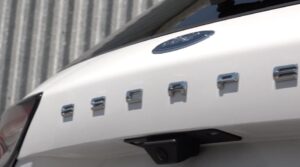 And now that Ford is almost exclusively a truck and SUV brand they’ve seized the opportunity to morph the Escape into something a little more car-like so as not to alienate shoppers who aren’t SUV crazy.
And now that Ford is almost exclusively a truck and SUV brand they’ve seized the opportunity to morph the Escape into something a little more car-like so as not to alienate shoppers who aren’t SUV crazy.
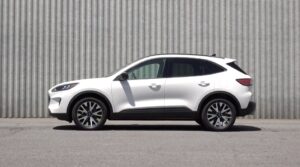 And yes, believe it or not, those people still exist. Lower, wider, longer and more aerodynamic, the new Escape resembles less the tough little SUV it once did and more the bastard child of a Porsche Cayenne and Tesla Model 3. Thankfully, this is the Escape’s worst crime as the rest of it is actually very good.
And yes, believe it or not, those people still exist. Lower, wider, longer and more aerodynamic, the new Escape resembles less the tough little SUV it once did and more the bastard child of a Porsche Cayenne and Tesla Model 3. Thankfully, this is the Escape’s worst crime as the rest of it is actually very good.
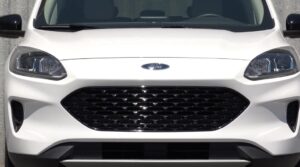 There are 9 specific trim levels with a starting MSRP of $26,130 and look who’s back; the Escape Hybrid. Originally produced between 2004 and 2012, it didn’t make the cut for the redesigned 2013 model year. But here I have the SE Sport; the most affordable Escape Hybrid. With AWD and nicely optioned, this one checks in at $35,295.
There are 9 specific trim levels with a starting MSRP of $26,130 and look who’s back; the Escape Hybrid. Originally produced between 2004 and 2012, it didn’t make the cut for the redesigned 2013 model year. But here I have the SE Sport; the most affordable Escape Hybrid. With AWD and nicely optioned, this one checks in at $35,295.
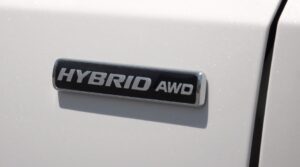 The Hybrid ‘s new briefcase-shaped lithium-ion battery resides outside of the vehicle under the rear seat area and takes up only a third of the space of the old battery. So engineers were able to improve head-, shoulder- and hip room while mostly limiting the reduction of cargo volume as compared with the gas model…it loses about 5 cubic feet.
The Hybrid ‘s new briefcase-shaped lithium-ion battery resides outside of the vehicle under the rear seat area and takes up only a third of the space of the old battery. So engineers were able to improve head-, shoulder- and hip room while mostly limiting the reduction of cargo volume as compared with the gas model…it loses about 5 cubic feet.
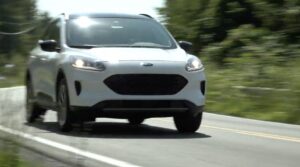 Though its displacement is the same, Ford says this 2.5-liter 4-cylinder, running on the hybrid-friendly Atkinson cycle, is all-new. Mated to the electronic CVT, total system output including the 88 kW electric motor is 198 horsepower. And with a weight loss of about 200 pounds, the Escape Hybrid smoothly and decisively steps off with an EV-like immediacy. And this one can do its fair share of electric driving, far beyond what you’d expect from a hybrid without a plug. By the way, Ford offers one of those too. Forty-eight percent of my weekly miles didn’t use any gas. In city driving in particular, the Escape beats the RAV4 and CR-V at hybrid economy.
Though its displacement is the same, Ford says this 2.5-liter 4-cylinder, running on the hybrid-friendly Atkinson cycle, is all-new. Mated to the electronic CVT, total system output including the 88 kW electric motor is 198 horsepower. And with a weight loss of about 200 pounds, the Escape Hybrid smoothly and decisively steps off with an EV-like immediacy. And this one can do its fair share of electric driving, far beyond what you’d expect from a hybrid without a plug. By the way, Ford offers one of those too. Forty-eight percent of my weekly miles didn’t use any gas. In city driving in particular, the Escape beats the RAV4 and CR-V at hybrid economy.
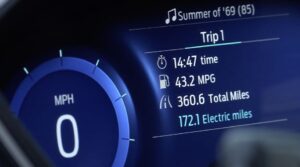 Hybrids used to be burdened with too many annoying traits, overwhelming their MPG advantages but much work has been done to, not only make them more likable, but in some instances actually make them the preferred powertrain. And this one is very good. Now, Ford’s Escape Hybrid strategy has changed little over the past 15 years electrically boosting a 2.5-liter 4-cylinder/eCVT pairing to produce better than car-like fuel economy in a small SUV. Back at its inception, this one would have returned 27mpg. Now, I’m averaging over 40 and the drive is impressive with only a couple of things I would tweak.
Hybrids used to be burdened with too many annoying traits, overwhelming their MPG advantages but much work has been done to, not only make them more likable, but in some instances actually make them the preferred powertrain. And this one is very good. Now, Ford’s Escape Hybrid strategy has changed little over the past 15 years electrically boosting a 2.5-liter 4-cylinder/eCVT pairing to produce better than car-like fuel economy in a small SUV. Back at its inception, this one would have returned 27mpg. Now, I’m averaging over 40 and the drive is impressive with only a couple of things I would tweak.
 For one, the regen brakes are unpredictable and still very hybrid-like and though the addition of numerous drive modes is cool, they’re chosen sequentially by a button on the center console making the process a little clumsy. The AWD system uses a disconnect feature to leave the rear wheels to move freely when not needed, but a Deep Snow/Sand Mode can lock them down. And if Sport mode does indeed include a stiffened suspension as Ford says I couldn’t tell. Nevertheless, it’s a nimble little think with an over 550 mile driving range.
For one, the regen brakes are unpredictable and still very hybrid-like and though the addition of numerous drive modes is cool, they’re chosen sequentially by a button on the center console making the process a little clumsy. The AWD system uses a disconnect feature to leave the rear wheels to move freely when not needed, but a Deep Snow/Sand Mode can lock them down. And if Sport mode does indeed include a stiffened suspension as Ford says I couldn’t tell. Nevertheless, it’s a nimble little think with an over 550 mile driving range.
 The Escape’s cabin feels very familiar, perhaps a little too much for a redesigned model. But nevertheless these seats are a little slice of heaven with lots of cushioning and the layout is simple and straightforward so you can just get in and go without any fussing. I like that. And this hybrid Powertrain is pretty amazing, delivering over 40 mpg with a quiet, torquey goodness.
The Escape’s cabin feels very familiar, perhaps a little too much for a redesigned model. But nevertheless these seats are a little slice of heaven with lots of cushioning and the layout is simple and straightforward so you can just get in and go without any fussing. I like that. And this hybrid Powertrain is pretty amazing, delivering over 40 mpg with a quiet, torquey goodness.
 Another new feature is the slide and recline 2nd row seats, making this space feel much larger than compact-sized. A small bump in the floor shouldn’t inhibit 3 across. No USB port, however.
Another new feature is the slide and recline 2nd row seats, making this space feel much larger than compact-sized. A small bump in the floor shouldn’t inhibit 3 across. No USB port, however.
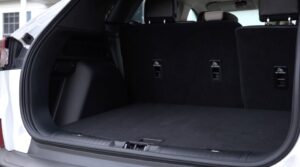 And the cargo area continues to play up the bigger than it seems narrative with a few cubbies underneath the floor to hold some smaller items. No hands-free liftgate on this one, though. Keep in mind, if you want more stuff than you see here there’s always the Titanium Hybrid.
And the cargo area continues to play up the bigger than it seems narrative with a few cubbies underneath the floor to hold some smaller items. No hands-free liftgate on this one, though. Keep in mind, if you want more stuff than you see here there’s always the Titanium Hybrid.
 Concerning SYNC, I continue to think Ford simplified this system too much in response to the poorly received old quadrant setup – one I actually liked – because this just seems very basic. The best part is the energy monitor…I like watching this sort of stuff. Adaptive cruise with lane centering and Stop & Go functionality is the highlight of Ford’s CoPilot 360 safety system but ironically that doesn’t include a 360 degree camera.
Concerning SYNC, I continue to think Ford simplified this system too much in response to the poorly received old quadrant setup – one I actually liked – because this just seems very basic. The best part is the energy monitor…I like watching this sort of stuff. Adaptive cruise with lane centering and Stop & Go functionality is the highlight of Ford’s CoPilot 360 safety system but ironically that doesn’t include a 360 degree camera.
 So, I like the new Escape. I really do. The hybrid works for me without too much trade off, the ride is soft and sumptuous and it’s sized right. But I don’t know if I could ever get over this mug. What was Ford thinking? And halogen headlights to boot?
So, I like the new Escape. I really do. The hybrid works for me without too much trade off, the ride is soft and sumptuous and it’s sized right. But I don’t know if I could ever get over this mug. What was Ford thinking? And halogen headlights to boot?
Ah yes. Batteries are expensive so did Ford cut some corners here? No doubt. The fit and finish of the cabin is lacking, the driver’s window switch is one-touch down not up, there’s no smart key access through the rear doors, no height adjustable passenger seat, and no engine cover…there’s something you don’t’ see much anymore. Just little things to keep the Hybrid base price at around $30 grand.
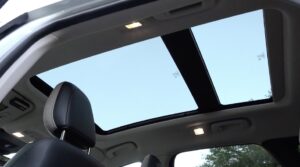 Soon, just about all of the most popular small SUVs will be available in hybrid form and this Ford is a good one…just don’t show it a mirror.
Soon, just about all of the most popular small SUVs will be available in hybrid form and this Ford is a good one…just don’t show it a mirror.
2020 Ford Escape Hybrid Review By Car Critic Steve Hammes | TestDriveNow | Drive Time with Steve Hammes

 ACURA NSX 2020 TEST DRIVE
ACURA NSX 2020 TEST DRIVE TOYOTA HIGHLANDER HYBRID PLATINUM AWD
TOYOTA HIGHLANDER HYBRID PLATINUM AWD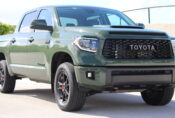 TOYOTA TUNDRA TRD PRO 2020 QUICK TAKES
TOYOTA TUNDRA TRD PRO 2020 QUICK TAKES